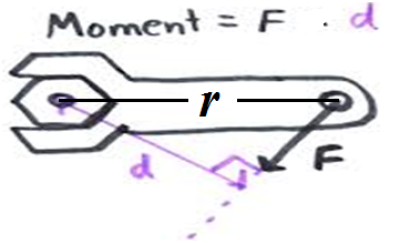Course description
Torque: In physics, a moment is a turning effect of a force. In principle, any physical quantity can be multiplied by distance to produce a moment; commonly used quantities include forces, masses, and electric charge distributions. For examples,
the moment of force, or torque (τ), is a 1st moment: , or, more generally, ,
the electric dipole moment is also a 1st moment:
the moment of inertia is a 2nd moment: for a point mass.
Fig. 33
Torque: It is a measure of how much a force acting on an object causes that object to rotate. The object rotates about an axis, which we will call the pivot point ‘O’. We will call the force 'F'. The distance from the pivot point to the point where the force acts is called the moment arm, and is denoted by 'r'. Note that this distance, 'r', is also a vector, and points from the axis of rotation to the point where the force acts.
Torque is defined as: τ = |r x F| =r F sin φ.
Fig. 34
However, torque, moment, or moment of force is rotational force (Fig. 35). Just as a linear force is a push or a pull, a torque can be thought of as a twist to an object (Fig. 36). The unit is newton metre (N m).
Fig. 35 Fig. 36
A bigger force does mean a bigger torque. But a bigger distance away from that force - a bigger lever - also means a bigger torque. If you try to lift a heavy object by putting a lever underneath it, a longer lever will make the job easier (Fig. 37).
Fig. 37
Problem 7: A force of 5.0 N is applied at the end of a lever that has a length of 2.0 meters. If the force is applied directly perpendicular to the the lever, what is the magnitude of the torque acting on the lever? If the same force is applied at an angle of 30 degrees at the end of the 2.0 meter lever, what will be the magnitude of the torque?
Solution: Torque = Force × lever = F × r sin 900 = 5.0 N × 2.0 m = 10 N m
Again, Torque = F × r sin θ = (5 N) (2 m) sin 300 = 10 sin 300 = 5 Nm
Relationship in torque, power and energy:
Power can be calculated from torque if the rotational speed is known. In fact, the horsepower of an engine is not typically measured directly, but calculated from measured torque and rotational speed. The relationship is:
Power = Force × Distance /Time = F × 2πr/T = τ ω (ω in radian/sec)
Moment of inertia:
The mass moment of inertia, usually denoted by I, measures the amount to which an object resists rotational acceleration about a particular axis, and is the rotational analogue to mass. Mass moments of inertia have units of dimension ML2 ([mass] × [length]2). The mass moment of inertia is often also known as the rotational inertia, and sometimes as the angular mass.
When a body is rotating, or free to rotate, around an axis, a torque must be applied to change its angular momentum. The amount of torque needed to cause any given angular acceleration (the rate of change in angular velocity) is proportional to the moment of inertia of the body. Moment of inertia may be expressed in units of kilogram meter squared (kg·m2) in SI units and pound-square feet (lb·ft2) in imperial or US units.
Fig. 38
A rigid body of mass M (m1+m2+ ----- +mn) is rotating with a uniform angular velocity (ω) about a particular axis of rotation, PQ (Fig. 38).
Let T is the time-period, then the linear velocity of the m1 particle,v1=(2πr1)/T=ωr1
Therefore, the kinetic energy of the m1 particle,
The total kinetic energy of the rigid body,
where I is the moment of inertia of the body and which is the sum of each of the mr2 terms, that is
Thus, moment of inertia is a physical property that combines the mass and distribution of the particles around the rotation axis. Notice that rotation about different axes of the same body yield different moments of inertia. The moment of inertia (I), however, is always specified with respect to given axis and is defined as the sum of the products obtained by multiplying the mass of each particle of matter in a given body by the square of its distance from the axis.
Moment of inertia I is defined as the ratio of the angular momentum L of a system to its angular velocity ω around a principal axis, that is
I=L/ω
If the angular momentum of a system is constant, then as the moment of inertia gets smaller.
Q. 13: Derive the moment of inertia of an uniform rigid rod of length L and mass M about an axis perpendicular to the rod and passing through O, at an arbitrary distance h from one end (Fig. 39).
Fig. 39
Moment of inertia, dI=dm x2
Now, lets find an expression for dm. Since the rod is uniform, the mass varies linearly with distance.
dm= M/L dx
Using the equation for dm, we substitute it into the first equation. Hence, we have:
dI= M/L x^2 dx
Now, I = ∫ dI
Substituting dI, (write the appropriate limits)
where the lower limit is -h because the left side of the rod is -h units away from the axis of rotation. (We take right as positive)
Solving the integration, we have:
Problem 8: A sphere is moving around in air. If the moment of inertia is 10 Kgm2 and radius of 1m, Calculate its mass?
Solution: Moment of inertia, I = 10 Kg m2,
Radius of sphere, K = 1m,
Moment of Inertia, I = MK2
Mass of the body, M = I / K2
= 10 Kg m2 / 1m2
= 10 Kg.


















